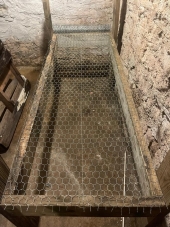RE: Alternative for bran
I bought a bale of shredded organically grown hemp straw that is used for horses. I have not used it yet. Culturing LAB requires a temperature of 20 - 25 degrees C and our weather has been too cold for that.
RE: Direct spraying food scraps
Sydney Tay in her video
Make Bokashi EMA from scratch by Rice water & Milk | Cheap Bokashi without bran | Indoor composting sprays her food scraps directly till she sees small droplets of water forming on the surface. Sometimes she also adds some plain (uninocculated) bran when she thinks it is getting to wet. The direct spray is at about the 8:00 minute timestamp of the video. Note that she lives in Malaysia with a hot tropical climate.
Her source for making the LAB/EM liquid is based on
Bokashi Bran Recipe - DIY with Rice Water (Fraser Valley Rose Farm)
Jason from that farm relies on the LAB culturing of Korean Natural Farming (KNF_ by Master Hankyu Cho. The original instructions can be found in the Indian version of the KNF book by Rohini Reddy:
https://ilcasia.files.wordpress.com/2012/02/chos-global-natural-farming-sarra.pdf
Note that the rice wash to milk ratio in the book is not the standard 1:10 but 2:1. And also unrefined cane sugar instead of the dreaded molasses that is very hard to get in Europe.
RE: EM-1 recipe
A video showing how the previous owner of EM USA taught how to make EM-1 in during a permaculture course in Belize. It does not use rice wash:
NEW Recipe: HOW TO MAKE EM-1 EFFECTIVE MICROORGANISMS - EM1 LACTOBACILLUS SERUM CULTURE INCOCULANT
The ingredients are:
molasses Greek yoghurt egg whitesactivated (dried) yeast 2 cups of soil dissolved in a gallon (US or UK?) of water
I have not made this yet, but the advantage is that you create a lot of EM-1 without using a lot of milk.



 Shows the strength of a forum format like permies.com. On Facebook or Reddit it is very difficult to search and react to older posts.
Shows the strength of a forum format like permies.com. On Facebook or Reddit it is very difficult to search and react to older posts.







